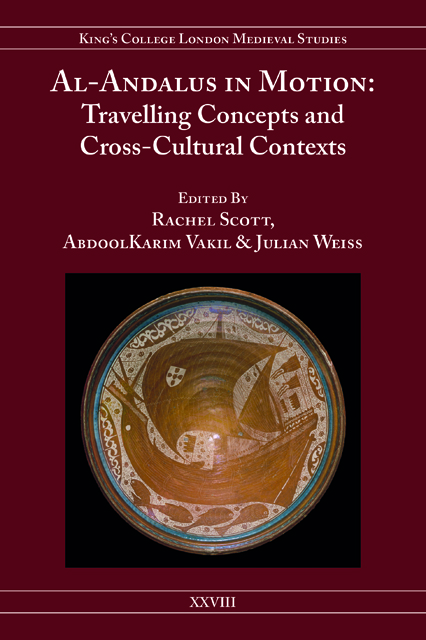Book contents
- Frontmatter
- Contents
- List of Illustrations
- Acknowledgements
- Notes on Contributors
- Part I Departure Points
- Part II Translating Al-Andalus: Travelling across Languages
- Part III (Re)Visions of Al-Andalus in Diaspora and Exile
- Part IV Andalusi Space as Node and Utopia: Europe, Islam, Empire
- Part V Al-Andalus and the Politics of Religious Identity
- Part VI Legacies, Landscapes and ‘Travel Buildings’
- Epilogue
- Index
4 - The Return to Al-Andalus in Blanco White’s ‘The Alcázar of Seville’
Published online by Cambridge University Press: 02 June 2023
- Frontmatter
- Contents
- List of Illustrations
- Acknowledgements
- Notes on Contributors
- Part I Departure Points
- Part II Translating Al-Andalus: Travelling across Languages
- Part III (Re)Visions of Al-Andalus in Diaspora and Exile
- Part IV Andalusi Space as Node and Utopia: Europe, Islam, Empire
- Part V Al-Andalus and the Politics of Religious Identity
- Part VI Legacies, Landscapes and ‘Travel Buildings’
- Epilogue
- Index
Summary
As Xavier Andreu Miralles has recently noted, Spanish intellectual and artistic discourses about al-Andalus experienced a turning point during the late eighteenth and early nineteenth centuries. This change was partly motivated by the emergence of the Romantic image of Spain in Northern Europe, an image of which Spanish intellectuals were aware and which, in turn, shaped the emerging discourses about the nation during the revolutionary cycle of 1808–33, between the Napoleonic invasion of Spain and the death of Ferdinand VII. The Romantic, exotic image of Spain was often assimilated, rejected or qualified by Spanish writers in a discursive process that was parallel to the emergence of Spanish nationalism itself during the Liberal Revolutions and its consolidation throughout the rest of the century (Miralles 2016: 117–27).
One of the key questions explored in Romantic literature was the role of Spain's Muslim past not only in shaping Iberian culture but also in articulating the Peninsula's relationship with the rest of Europe, at a time when Europe itself was reconfiguring its identity as a set of competing nation-states and rival colonial powers. One graphic example of this trend was Chateaubriand's Les Aventures du dernier Abencerage (1806; first published 1826). Chateaubriand appropriates the well-known legend of the doomed clan of Muslim noblemen (the Abencerraje), which circulated in countless versions – prose romances, ballads, plays, and operas – throughout Spain, Europe and North America since the sixteenth century, and turns it into an orientalist drama about exile, diaspora, moribund empires and France's civilising role on the world stage. His version of the tale is just one manifestation of a common image. It illustrates how, in Europe, world civilisation was often imagined as a tree, with a single origin branching out in different directions to reach different stages of development: the image highlighted the importance of al-Andalus, not just as an antiquarian curiosity, but as a site to understand the origins of European modernity, and in some cases the place of Iberia as Europe's internal Other.
The Romantic image of al-Andalus in the work of European writers and in particular travellers from the first couple of decades of the nineteenth century, projected a positive image of the Spanish past while somehow keeping it relegated to a secondary position. A land that was a perennial frontier between East and West, and between past and present, an internal Other to civilised Europe (Iarocci 2006: 1–52).
- Type
- Chapter
- Information
- Al-Andalus in MotionTravelling Concepts and Cross-Cultural Contexts, pp. 107 - 126Publisher: Boydell & BrewerPrint publication year: 2021



